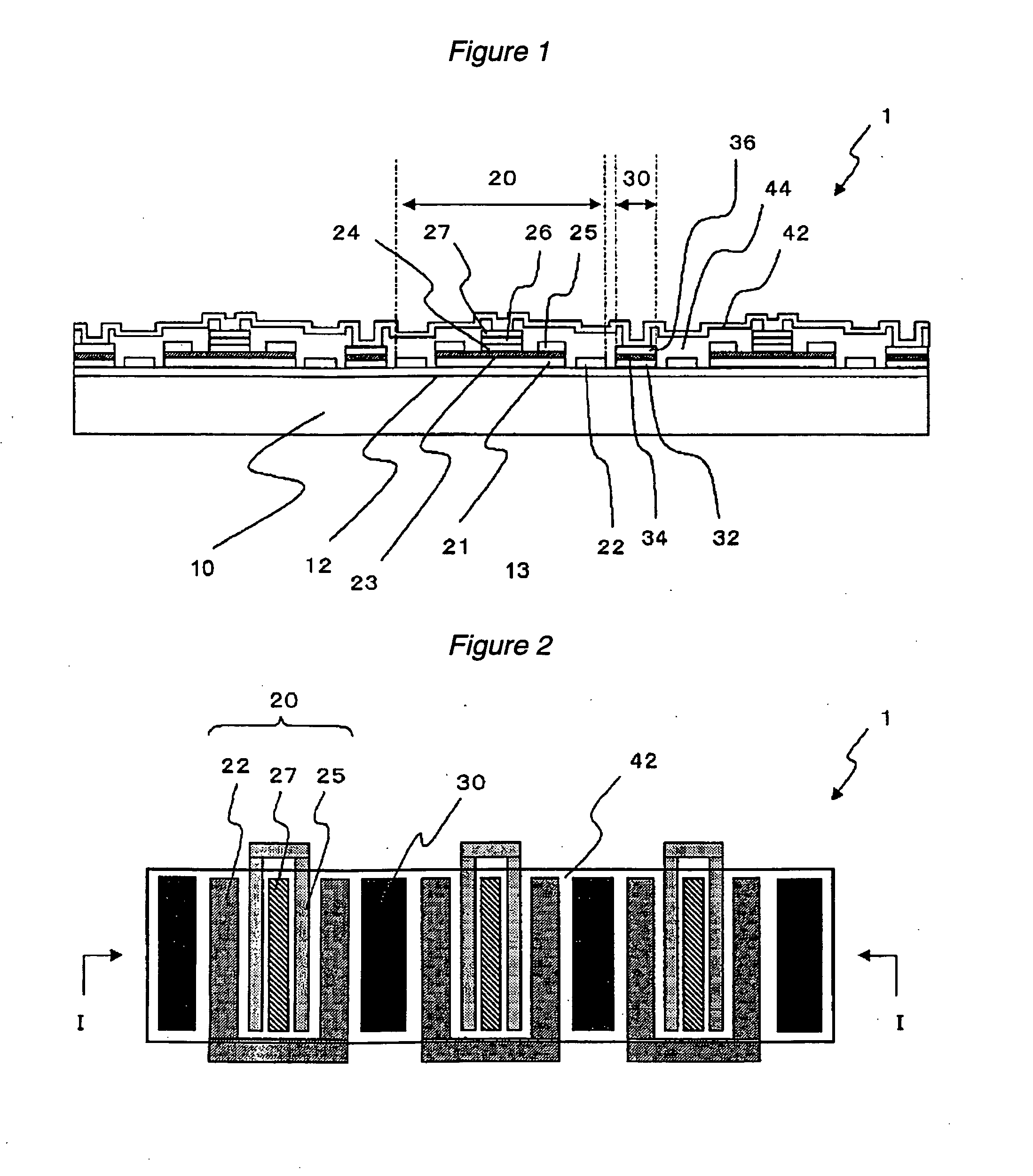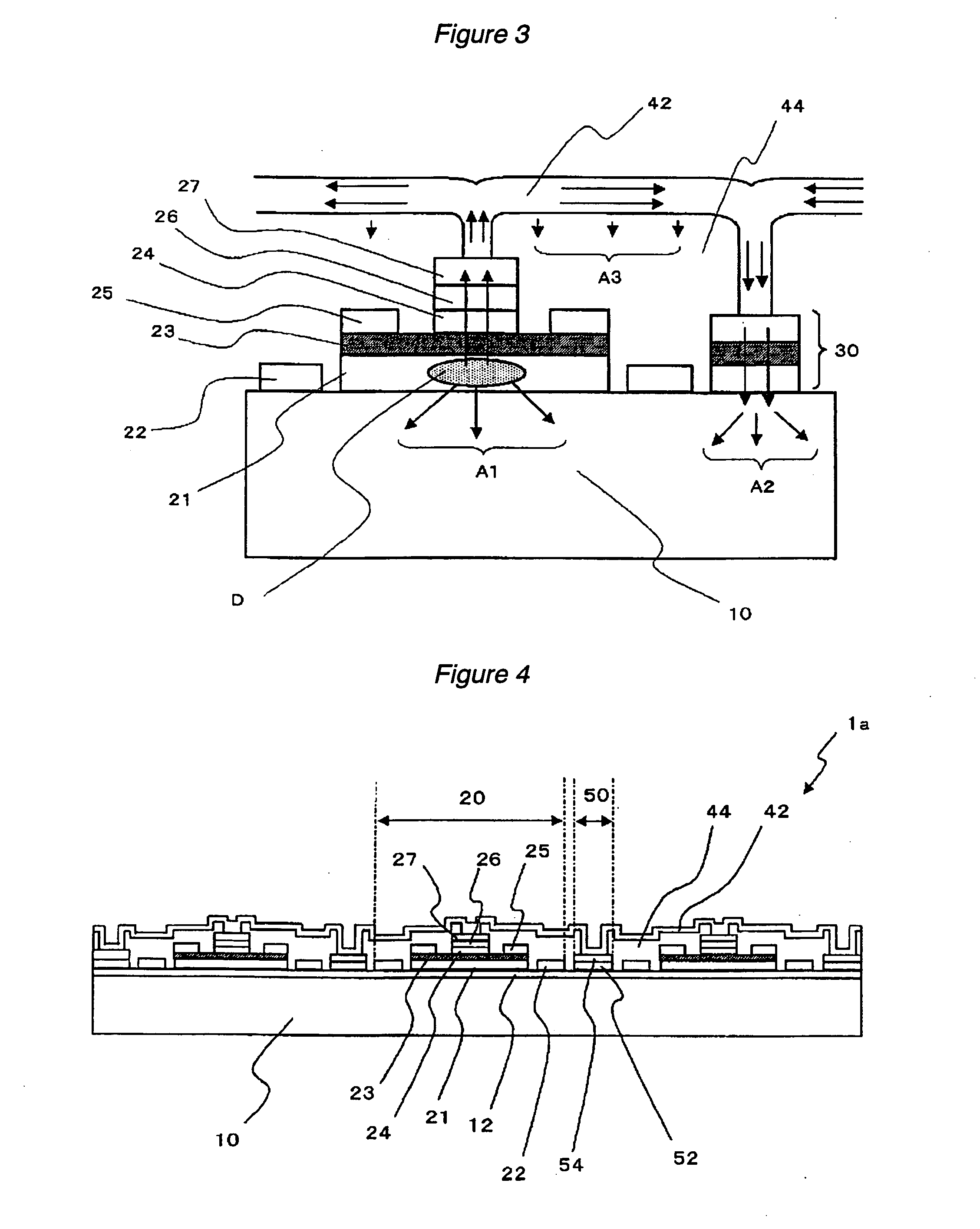Semiconductor Device
a technology of semiconductor devices and semiconductors, applied in semiconductor devices, semiconductor/solid-state device details, diodes, etc., can solve the problems of degrading electric characteristics, thermal runaway, and significantly limited performance of hbt operating with high power, and achieves high heat dissipation performance and inhibits the increase of chip area
- Summary
- Abstract
- Description
- Claims
- Application Information
AI Technical Summary
Benefits of technology
Problems solved by technology
Method used
Image
Examples
first embodiment
[0113]FIG. 1 is a sectional view showing a first embodiment of the semiconductor device according to the present invention. FIG. 2 is a plan view showing the first embodiment of the semiconductor device according to the present invention. FIG. 1 shows a cross-section taken along line I-I of FIG. 2.
[0114]Semiconductor device 1 of this embodiment is so called a high-output power semiconductor device of multi-cell structure having a plurality of n-p-n type HBTs formed on a semi-insulating semiconductor substrate. This embodiment is described with an example of using a semi-insulating semiconductor substrate as a semiconductor substrate, but an n type semiconductor substrate may be used or a p-n-p type HBT may be used as a matter of course.
[0115]Semiconductor device 1 shown in FIG. 1 comprises sub-collector layer 12 formed on the (001) plane of semi-insulating semiconductor substrate 10, HBTs 20 as unit semiconductor elements one-dimensionally and alternately arranged on sub-collector l...
second embodiment
[0164]FIG. 4 is a cross-sectional view showing a second embodiment of the semiconductor device according to the present invention. Semiconductor device 1a is different from semiconductor device 1 in the configuration of diode 50. Other configurations of semiconductor device 1a are same as those of semiconductor device 1. Diode 50 is a Schottky junction diode constituted by n type layer 42 and Schottky electrode 54 stacked in this order on sub-collector layer 12, and works for both the heat dissipating means and protection diode. Like n type layer 32 of FIG. 1, n type layer 52 has a composition same as that of collector layer 21 of HBT 20. Schottky electrode 54 is connected to emitter electrode 27 via common emitter wiring 42.
[0165]As a Schottky metal, a metal such as titanium, aluminum or tantalum may be used. When titanium is used as a Schottky metal, the configuration of Schottky electrode 54 may use, for example, a Ti / Pt / Au electrode.
[0166]Since the HBT of this embodiment is an n...
third embodiment
[0171]FIG. 5 is a cross-sectional view showing a third embodiment of the semiconductor device according to the present invention. FIG. 6 is a plan view showing the third embodiment of the semiconductor device according to the present invention. In semiconductor device 2, a plurality of HBTs 20 and a plurality of heat dissipating means 60 are one-dimensionally alternately arranged on semiconductor substrate 10. The configuration of HBT 20 is similar to that shown in FIG. 1.
[0172]Heat dissipating means 60 is constituted by metal film 62 formed on sub-collector layer 12 and insulating film 44 on metal film 62. Insulating film 44 is similar to the insulating film shown in FIG. 1. Namely, a portion of insulating film 44 provided on metal film 62 works as a part of heat dissipating means 60. Insulating film 44 of heat dissipating means 60 is connected to emitter electrode 27 of HBT 20 via common emitter wiring 42. In other words, insulating film 44 is interposed between metal film 62 and ...
PUM
 Login to View More
Login to View More Abstract
Description
Claims
Application Information
 Login to View More
Login to View More - R&D
- Intellectual Property
- Life Sciences
- Materials
- Tech Scout
- Unparalleled Data Quality
- Higher Quality Content
- 60% Fewer Hallucinations
Browse by: Latest US Patents, China's latest patents, Technical Efficacy Thesaurus, Application Domain, Technology Topic, Popular Technical Reports.
© 2025 PatSnap. All rights reserved.Legal|Privacy policy|Modern Slavery Act Transparency Statement|Sitemap|About US| Contact US: help@patsnap.com



